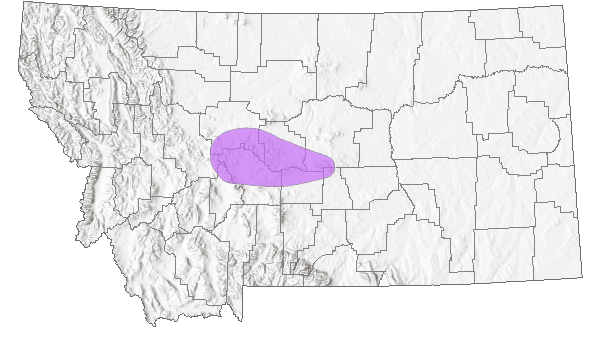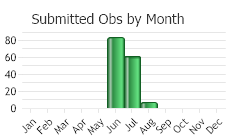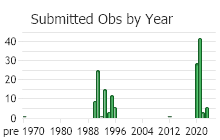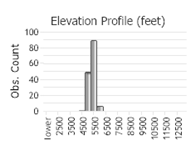View in other NatureServe Network Field Guides
NatureServe
Montana
Utah
Wyoming
Idaho
Wisconsin
British Columbia
South Carolina
Yukon
California
New York
Short-styled Columbine - Aquilegia brevistyla
State Rank Reason (see State Rank above)
See rank details.
- Details on Status Ranking and Review
Population Size
Score2 - Small: Generally 2,000-10,000 individuals.
CommentAdditional surveys are likely to find more occupied sites within the general area of the known occurrences.
Range Extent
Score3 - Local Endemic or Very Small Montana Range: Generally restricted to an area <10,000 sq. miles (equivalent to the combined area of Phillips and Valley Counties) or <6 Sub-basins (4th code watersheds) Range-wide OR limited to one Sub-basin in Montana
CommentMontana populations are highly disjunct from the main portion of the species' range in Canada and Alaska.
Area of Occupancy
Score2 - Low: Generally occurring in 4-10 Subwatersheds (6th Code HUC’s).
Environmental Specificity
Score1 - Moderate: Species is restricted to a specific habitat that is more widely distributed or to several restricted habitats and is typically dependent upon relatively unaltered, good-quality habitat (C Values of 5-7).
Trends
ScoreNA - Rank factor not assessed.
CommentTrends are unknown, though there is no indication that the species' has experienced significant declines in Montana. Habitat is generally stable.
Threats
Score0-1 - Low to Medium.
CommentPotential threats to the species' viability or individual populations are likely either minor in severity or localized in scope.
Intrinsic Vulnerability
Score0-1 - Low to Moderate Vulnerability.
Raw Conservation Status Score
Score
8 to 10 total points scored out of a possible 16 (Rarity factors and threats only).
General Description
Short-styled Columbine is a slender, sparingly branched, perennial with stems up to 80 cm tall that are lightly pubescent below and glandular above. The basal leaves have long petioles with blades that are lobed and wavy-margined; the few-stemmed leaves are lobed and nearly without petioles. The typical columbine flowers are 15-25 mm long with blue or purple reflexed sepals and yellowish-white, horn-shaped petals; the bluish spurs of the petals are curved inward at the tip and are 6-8 mm long. Stamens and styles barely protrude beyond the petals; the five-lobed seed capsules are pubescent.
Phenology
Flowering in June-early July.
Diagnostic Characteristics
This species can be distinguished from other blue-flowered columbines in Montana by the incurved tips of the petal spurs.
Species Range
Montana Range
Range Descriptions

 Native
Native
Range Comments
Eastern Alaska to Ontario south to British Columbia and southern Manitoba. Disjunct in eastern Montana and the Black Hills of South Dakota and Wyoming.
Observations in Montana Natural Heritage Program Database
Number of Observations: 157
(Click on the following maps and charts to see full sized version)
Map Help and Descriptions
Relative Density

Recency



 (Observations spanning multiple months or years are excluded from time charts)
(Observations spanning multiple months or years are excluded from time charts)
Habitat
Open woods and stream banks at mid-elevations in the montane zone.
National Vegetation Classification System Groups Associated with this Species
Forest and Woodland
Montane - Subalpine Forest and Woodland
Ecology
POLLINATORS The following animal species have been reported as pollinators of this plant species or its genus where their geographic ranges overlap:
Bombus vagans,
Bombus sitkensis, and
Bombus impatiens (Macior 1968, Thorp et al. 1983, Colla and Dumesh 2010).
Stewardship Responsibility
Threats or Limiting Factors
STATE THREAT SCORE REASON
Reported threats to Montana's populations of Short-styled Columbine include a loss of plants where a campground was reconstructed, trampling from off-highway vehicle (OHV) activity, competition from noxious weeds, and trampling by livestock (MTNHP Threat Assessment 2021).
References
- Literature Cited AboveLegend:
 View Online Publication
View Online Publication Colla, S.R. and S. Dumesh. 2010. The bumble bees of southern Ontario: notes on natural history and distribution. Journal of the Entomological Society of Ontario 141:39-68.
Colla, S.R. and S. Dumesh. 2010. The bumble bees of southern Ontario: notes on natural history and distribution. Journal of the Entomological Society of Ontario 141:39-68. Macior, L.M. 1968. Bombus (Hymenoptera, Apidae) queen foraging in relation to vernal pollination in Wisconsin. Ecology 49:20-25.
Macior, L.M. 1968. Bombus (Hymenoptera, Apidae) queen foraging in relation to vernal pollination in Wisconsin. Ecology 49:20-25. MTNHP Threat Assessment. 2021. State Threat Score Assignment and Assessment of Reported Threats from 2006 to 2021 for State-listed Vascular Plants. Botany Program, Montana Natural Heritage Program, Helena, Montana.
MTNHP Threat Assessment. 2021. State Threat Score Assignment and Assessment of Reported Threats from 2006 to 2021 for State-listed Vascular Plants. Botany Program, Montana Natural Heritage Program, Helena, Montana. Thorp, R.W., D.S. Horning, and L.L. Dunning. 1983. Bumble bees and cuckoo bumble bees of California (Hymenoptera: Apidae). Bulletin of the California Insect Survey 23:1-79.
Thorp, R.W., D.S. Horning, and L.L. Dunning. 1983. Bumble bees and cuckoo bumble bees of California (Hymenoptera: Apidae). Bulletin of the California Insect Survey 23:1-79.
- Additional ReferencesLegend:
 View Online Publication
View Online Publication
Do you know of a citation we're missing? Dawe, J. C. and D. F. Murray. 1981. Chromosome numbers of selected Alaskan vascular plants. Canadian Journal of Botany 59:1373-1381.
Dawe, J. C. and D. F. Murray. 1981. Chromosome numbers of selected Alaskan vascular plants. Canadian Journal of Botany 59:1373-1381. Ladyman, Juanita. 2006. Aquilegia brevistyla Hooker (Smallflower Columbine): A Technical conservation Assessment. Prepared by JnJ Associates LLC, Centential, Colorado. Prepared for USDA Forest Service, Rocky Mountain Region, Species Conservation Project, Lakewood, Colorado.
Ladyman, Juanita. 2006. Aquilegia brevistyla Hooker (Smallflower Columbine): A Technical conservation Assessment. Prepared by JnJ Associates LLC, Centential, Colorado. Prepared for USDA Forest Service, Rocky Mountain Region, Species Conservation Project, Lakewood, Colorado. Lesica, P., M.T. Lavin, and P.F. Stickney. 2012. Manual of Montana Vascular Plants. Fort Worth, TX: BRIT Press. viii + 771 p.
Lesica, P., M.T. Lavin, and P.F. Stickney. 2012. Manual of Montana Vascular Plants. Fort Worth, TX: BRIT Press. viii + 771 p. Lesica, P., M.T. Lavin, and P.F. Stickney. 2022. Manual of Montana Vascular Plants, Second Edition. Fort Worth, TX: BRIT Press. viii + 779 p.
Lesica, P., M.T. Lavin, and P.F. Stickney. 2022. Manual of Montana Vascular Plants, Second Edition. Fort Worth, TX: BRIT Press. viii + 779 p. Mathews, S.Y. 1989. Sensitive plant surveys, 1989: United States Forest Service, Region 1, Gallatin National Forest, Montana. Unpublished report to the USDA Forest Service, Gallatin National Forest, Bozeman, Montana. Montana Natural Heritage Program, Helena, MT. 85 pp.
Mathews, S.Y. 1989. Sensitive plant surveys, 1989: United States Forest Service, Region 1, Gallatin National Forest, Montana. Unpublished report to the USDA Forest Service, Gallatin National Forest, Bozeman, Montana. Montana Natural Heritage Program, Helena, MT. 85 pp. Roe, L.S. 1992. Status review of Aquilegia brevistyla, USDA Forest Service, Region 1, Lewis & Clark National Forest. Unpublished report. Montana Natural Heritage Program, Helena, MT. 47 pp.
Roe, L.S. 1992. Status review of Aquilegia brevistyla, USDA Forest Service, Region 1, Lewis & Clark National Forest. Unpublished report. Montana Natural Heritage Program, Helena, MT. 47 pp.
- Web Search Engines for Articles on "Short-styled Columbine"





